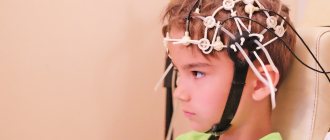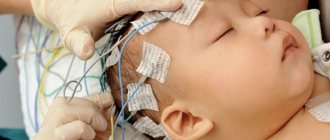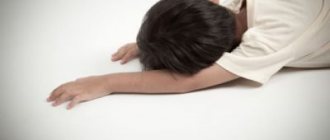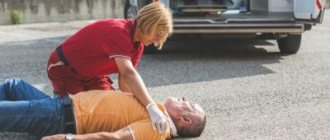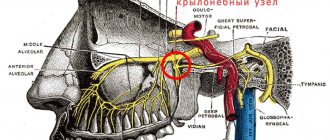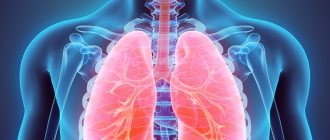Heart rhythm disorders (cardiac arrhythmia)
Impaired consciousness during syncope is caused by insufficient blood flow to the brain, which in turn is partly caused by a decrease in cardiac output. This volume may also be lower than normal if the heart rhythm is abnormal. Minute volume decreases at both very slow and very fast heart rates. It is difficult to distinguish between disturbances of consciousness resulting from a heart rhythm disorder and an epileptic seizure. In some cases, however, a person nearby can determine that during the attack the victim’s pulse was absent or very uneven, and sometimes the victim himself notices a rapid heartbeat before loss of consciousness.
Heart rhythm can be easily monitored using electrocardiography. The voltage changes associated with contraction of the various chambers of the heart are of sufficient amplitude that they can be easily recorded on a cassette recorder over 24-hour periods and their occurrence analyzed in relation to symptoms. A cardiac cause of impaired consciousness is found in approximately 1/4 of patients who first seek neurological consultations for temporary loss of consciousness.
Blood pressure and epilepsy
Epilepsy is a disease that occurs due to disturbances in the electrical activity of the brain. Recently, scientists have been increasingly interested in the question: how should blood pressure behave after the onset of convulsions - should it fall or rise? The vasomotor theory states that the generalization of an attack causes a rise in blood pressure due to a violation of central mechanisms and vasospasms. Other researchers believe that a sharp decrease in pressure is enough to trigger a seizure. Therefore, it is necessary to consider in more detail the essence of the disease and the achievements of recent years in the study of the topic raised.
The essence of epilepsy
There are two main forms of the disease - primary/idiopathic and secondary/symptomatic. According to statistics, 75% of epileptics are patients under 20 years of age, and the remaining 25% are mainly people who have suffered injury or stroke. In the first case of epilepsy, seizures are detected in childhood, but no organic changes are detected in the brain. With this type, the threshold of excitability decreases, and treatment of the disease gives a good effect, and with age, most often, therapy is canceled due to unnecessaryness. The second form of pathology is characterized by damage to brain structures or metabolic disorders, and recovery is possible only if the provoking disease is successfully treated.
Why does the disease occur and how does it manifest?
As mentioned above, depending on the type of epilepsy, there are two groups of causes: congenital and acquired. The most common causes for the occurrence of the disease are: head injury, hypoxia during childbirth, oncological diseases of the brain, its viral lesions and structural disorders, abscesses.
In patients with epilepsy, the following types of seizures are distinguished: partial, generalized, mixed. Depending on the type, the symptoms of the disease will differ:
- Jacksonian attacks - excitement affects only part of the brain, so the attack spreads to one muscle group, and the patient’s consciousness is preserved. The seizures last a couple of minutes.
- Grand mal seizure - the whole brain is involved in the process. Characterized by increased anxiety, tonic and clonic convulsions, when muscles contract uninterruptedly.
- Minor seizures are manifested by sharp hypo- or hypertonicity, absence seizures - momentary disconnections from reality. After an epileptic attack, the patient does not remember the incident.
- Status epilepticus is a series of seizures, between which consciousness does not return, and reflexes and tone are not restored. Lack of medical care leads to the death of the patient.
How are blood pressure and epilepsy related?
The brain instantly reacts to circulatory disorders due to sensitivity to lack of oxygen. And blood supply, in turn, depends on the pressure and resistance of the cerebral vessels. According to Selbach's work, low blood pressure can be a trigger for an attack. However, Kralf said that the heightened susceptibility of the vasomotor centers of the brain and blood vessels correlates with epireadiness. Increased intracranial pressure, for example, due to an infectious process, can also cause a seizure - the mechanism of occurrence of epileptic activity is mediated by metabolism and blood circulation in the brain.
Characteristics of blood pressure during an attack
There are conflicting opinions regarding this indicator. Some scientists indicate that the effect on the carotid sinus, due to which the pressure drops, causes a seizure in patients with epilepsy. Other studies have shown that taking an antihypertensive drug can help prevent attacks and stop the progression of brain damage. This version is also supported by the recorded increase in albumin in the blood, which leads to vascular hypertonicity, and therefore to an increase in blood pressure. It is important that increased intracranial pressure is also recorded during instrumental diagnostics.
Sources used: etodavlenie.ru
YOU MAY BE INTERESTED in: Epilepsy symptoms signs causes consequences Can EEG cause an epileptic attack What to do with a hangover
Localized reduction in cerebral blood flow similar to epilepsy
The changes in blood flow discussed above affect equally all areas of the brain. In older people, atherosclerotic changes are observed in the arteries of the neck and head. An artery in one part of the brain may be temporarily blocked by a piece of limescale or a blood clot carried by the bloodstream from a larger artery. Neurologists call this condition “transient ischemic crisis.” In some of these short-lived episodes, muscle weakness or a tingling sensation in one limb or the other may be mildly reminiscent of partial motor or sensory seizures (see website). And although focal motor seizures may originate from a part of the brain where stroke scar has formed where arteries are permanently blocked by a stroke, transient ischemic crises are associated with temporary paralysis rather than seizures.
In young people, localized (focal) neurological changes occur with migraine. In the first stage of a classic migraine attack, arterial spasm occurs, reducing focal cerebral blood flow. It is not yet entirely clear whether this condition is primary in relation to some suppression of nerve cell activity. The occipital region is most often affected. The result is hallucinations in the form of distorted objects or flashing lights, rather than full-blown visual hallucinations, which may be one of the manifestations of a partial seizure of temporal origin (see website). Sometimes the spasm affects the motor or sensory area of the brain, causing short-term paralysis or disturbance of perception on the opposite side of the body without seizures.
Narcolepsy is similar to an epileptic seizure
Any of us can feel drowsy while in a stuffy classroom or traveling in a car for a long time. However, people with narcolepsy experience an irresistible urge to sleep in other places and may actually fall asleep in completely inappropriate circumstances. This unusual symptom may be associated with “cataplexy,” a sudden loss of postural tone causing collapse without loss of consciousness, often as a result of strong emotions such as anger or joyful surprise. In some ways these phenomena are very close to epilepsy, since they are probably the result of some paroxysmal disturbances of the nerve cells of the brain. However, these patients do not experience epileptic seizures more frequently than the general population, their waking EEG is always normal, and benefit can be achieved with a completely different type of medication than those used for epilepsy.
Myth 1. Epilepsy is a mental illness that should be treated by psychiatrists.
In fact. 20–30 years ago, the treatment of epilepsy was indeed considered the prerogative of psychiatrists, but thanks to the efforts of the All-Russian Society of Neurologists it became the field of neurology. Which, according to leading epileptologists (specialists involved in the treatment of this disease), is completely justified: the origin of the disease (especially in adult patients) is closely related to strokes, tumors, vascular lesions of the brain, traumatic brain injury, tick-borne encephalitis, metabolic disorders ( uremia, liver failure, hypoglycemia), etc.
There are three forms of epilepsy - symptomatic (in which the patient has a structural defect in the brain), idiopathic (when there are no such changes, but there is a hereditary predisposition to the disease) and cryptogenic (when the cause of the disease cannot be identified).
Falls can be similar to epilepsy
Similar phenomena are observed only in middle-aged women, and often within f-2 years. The picture observed is extremely unusual. A woman complains that while walking she suddenly feels like her legs are buckling. She may fall to her knees or hit her face. In any case, she is absolutely sure that she is perfectly aware of everything that is happening and is equally sure that she did not stumble. It is believed, with varying degrees of certainty, that the cause of this condition is weakness of the thigh muscles or impaired blood flow to the brainstem affecting postural reflexes. Whatever the mechanism of this phenomenon, neurologists believe that it has nothing to do with epilepsy.
Myth 8. We say epilepsy, but we mean dementia
In fact. Because of this misconception, many patients with epilepsy suffered, for whom the presence of this diagnosis prevented them from entering school, university, or getting a job. Epileptologists never tire of repeating: their patients, most of whom are no different from healthy people during the period between attacks, do not need any special restrictions.
Sports (especially play sports) are also useful for epilepsy, except for swimming and cycling (due to the mentioned photostimulating effect).
The only prohibited activities are those associated with extreme conditions: driving a car, serving in the police, fire departments, guarding important facilities, working with moving mechanisms, chemicals, near water bodies.
Dizziness may be similar to an epileptic attack
Doctors are very careful to distinguish between true dizziness, i.e. a feeling of loss of balance of the body relative to space, from non-specific sensations in the head, which can be described as “emptiness” or “fog” and which are very often associated with anxiety and depression. True dizziness is rarely a symptom of a partial seizure of temporal origin. Much more often it is a consequence of dysfunction of the balancing organ (labyrinth) located in the inner ear. Labyrinth dysfunction is occasionally observed in both adults and children. In young children it is quite difficult to distinguish vertigo of paroxysmal origin from a partial seizure, since in both cases the child is frightened and can either grab onto the mother or fall. Differentiation is based on the absence of amnesia or confusion after an attack of harmless paroxysmal vertigo and on positive results in the study of labyrinthine function.
Personality changes in epilepsy
Relatives often notice certain changes in the character of patients. They become too selfish and irritable due to difficulties in adapting to this pathology. In children, such signs appear extremely rarely, but in adults they occur due to the following factors:
- Taking medications to relieve attacks;
- Insufficient support from loved ones;
- Secondary pathologies.
Personality changes can be both a cause and a consequence of the disease. As a rule, their nature is secondary: it is difficult for a person to understand and come to terms with the disease and its clinical symptoms. If in children signs of personality changes are rarely pronounced, then with age they become more pronounced and it is more difficult to live with them.
Among the reasons for changes in behavior and emotional state are:
- taking medications prescribed to prevent seizures (AES);
- lack of understanding and support among loved ones and relatives;
- personal emotional status, character type (it has been noticed that cheerful optimists have a simpler attitude towards problems);
- accompanying illnesses.
In children, the presence of neurological abnormalities is often accompanied by epileptic seizures, and can lead to mental retardation.
Trembling may resemble an epileptic attack
In some cases, fever-related shivering, especially common with urinary tract infections, can be confused with a seizure. Nightmares Such phenomena are common in children aged 5-10 years and are often a cause of concern for parents. A typical picture: a child, having slept for 1 - 3 hours, suddenly wakes up and starts screaming. He sits in bed with his eyes wide open, not reacting to what is happening around him, and it is impossible to calm him down. After about a minute, the child lies down, turns away and continues to sleep. The next morning he doesn't remember anything. All that is required in such cases is to reassure the parents.
Myth 3. Epilepsy is necessarily inherited
Disability due to epilepsy in children occurs with delayed motor and speech development, frequent seizures, and in the presence of other factors. A child is diagnosed with a disability when motor development is delayed for three age periods. Epilepsy with speech impairment after the onset of the disease, delayed speech development (ONR, DRR, dysarthria, alalia), a combination of motor and speech development disorders become the basis for disability.
Disability is also issued for concomitant hearing and vision impairment, forms of epilepsy with impaired motor activity, and mental disorders. Children are not assigned disability groups, but are assigned a category - disabled since childhood. When a child becomes an adult, he undergoes disability registration according to the scheme for adults with epilepsy and is assigned a certain disability group.
Tic, habits, ritualistic movements are similar to manifestations of epileptic disease
Tics in children usually affect the upper part of the face and manifest as eye rolling or frequent blinking. More complex habits such as snoring or brushing hair out of the eyes are quite common among children and are rarely confused with seizures. However, sometimes children have strange motor habits in which they find obvious pleasure, but, upon receiving a reprimand, they immediately stop such movements. Sometimes babies and toddlers rock back and forth, making movements with their hips that resemble masturbation.
Pediatric neurology
Such a severe pathology as epilepsy is traditionally difficult to diagnose. Its most characteristic symptom is an epileptic seizure, which cannot always be observed in a clinical setting, but if epiactivity on the child’s EEG can be recorded during examination, the diagnosis can be considered confirmed.
An extreme manifestation of the disease, or an epileptic seizure, is a short-term unprovoked stereotypical disorder in behavior, consciousness, emotional activity, sensory or motor functions. A similar, epileptiform seizure often occurs, which is not considered a basis for a diagnosis of epilepsy. In such cases, an accurate diagnosis is made if epiactivity manifests itself on the EEG.
Video-EEG monitoring is important in the diagnosis and differential diagnosis of epilepsy.
It is important not to confuse increased breathing with an epileptic seizure.
Excessively frequent and deep inhalations and exhalations are one of the body's reactions through which, like a rapid heartbeat, anxiety manifests itself. This reaction appears to be particularly common in teenage girls. If it lasts longer than a few minutes, the lungs remove excess carbon dioxide from the blood, which becomes alkaline. This affects the amount of calcium in the blood, and therefore the conduction of nerve impulses and muscle contraction. The net effect is that the person feels a painful tingling sensation in the arms and toes, which bend and clench into a cramping position. The lack of carbon dioxide also causes a feeling of dizziness, and the overall picture can be confused with that seen during a seizure. Treatment in such cases is simple and extremely effective. The patient's nose and mouth are covered (briefly) with a piece of paper or a plastic bag, which allows him to re-breathe his exhaled air, which is saturated with carbon dioxide. The body's chemical processes and clinical condition quickly return to normal.
In what cases can you count on the group?
In some cases, treatment leads to the fact that the symptoms of epilepsy completely disappear and the person recovers. Other patients need to constantly take special medications to prevent attacks from recurring.
At the same time, they can live a full life and work. But if attacks are repeated so often that a person becomes incapable of normal life activities and work, then he can count on receiving a disability group.
For epilepsy, you can receive one of three disability groups, depending on the severity and frequency of attacks:
- In Russia, according to statistics, about 40% of patients receive the third group, the majority of them are children. Anyone who is sick can receive it if they suffer from attacks of moderate intensity and mild cognitive impairment. Patients who received this group are under social protection and continue to work.
- If a person experiences significant cognitive seizures and mental impairment, as a result of which he cannot fulfill work obligations, then he may receive a second group of disability. Children in this group can continue their studies in special conditions.
- Only 2-4% of patients with epilepsy receive the first group of disability. They have severe dementia, and the disease is severe. Children with this form of the disease rarely survive to adulthood.
Patients of the first and second groups are given lifelong disability if there is no improvement within 5 years.
Simulating epileptic seizures
It may seem strange that someone would want to feign an epileptic seizure, but in the practice of consulting physicians this is one of the most common cases when it is necessary to resort to differential diagnosis. The vast majority of these patients know something about epilepsy: either they have observed seizures in their relatives, or (more often) they themselves have had actual seizures. Until a specialist learns to distinguish between true and imaginary seizures, he may not be able to accurately determine the phenomenon he is observing. The doctor may fall into the trap of being forced to prescribe more and more antiepileptic drugs to treat seizures that he or she feels are uncontrollable. And vice versa, observing one seizure, in which the doctor is sure is imaginary, he may mistakenly believe that all the others are also simulated.
True seizures can be distinguished from imaginary seizures by the nature of seizures, which often cannot be imitated skillfully enough. A colleague of the authors (David Marsden) quite rightly noted that they are “strengthened by coercion and weakened by inattention.” Urinary incontinence is not a differentiating feature, since it can be simulated, which in many cases is successful. Virtually irrefutable evidence of malingering can be considered a formal EEG recorded during a generalized “seizure.”
However, convulsive movements of patients can spoil the recording so much that its interpretation is very difficult. In many cases, video recording in combination with EEG is more beneficial.
Psychiatrists (rightly or wrongly) make a distinction between a person’s feigning of illness due to his conscious desire to appear sick, for example, to avoid conscription into the army, and unconscious hysteria, in which the simulation is supposedly the product of subconscious mental activity. In any case, some potential benefit to the patient is clear. By faking seizures, people usually try to attract more attention to themselves. Instead of blaming such patients, doctors should regard such events as evidence that patients are unable to cope with their life problems, and do everything in their power to help them and protect them from blame.
Finally, seizures can occur in a number of other diseases or systemic disorders. This is, for example, hypoglycemia (low blood sugar), which can develop in diabetic patients if too large doses of insulin are prescribed for their treatment; renal and liver failure; respiratory failure; alcoholism and withdrawal states; inborn errors of metabolism (see website). In conclusion, it should be noted that in all cases it is necessary to be aware of the potential consequences of prescribing illicit drugs to provoke seizures.
How to live with a diagnosis?
Most patients do not experience intellectual changes that interfere with living a normal life. Work can be selected taking into account the characteristics, and studying should in no way bring discomfort. Those teachers who refuse to admit a child to school on the basis of his diagnosis and with the argument “not to scare other children during an attack, if it happens” are wrong.
Patients with epilepsy have always frightened society. Although among the people who suffered from this pathology were famous personalities: Alexander the Great, Gaius Julius Caesar, Napoleon Bonaparte, Peter the Great, Fyodor Dostoevsky. These are all extraordinary people with high intellectual potential. Today doctors know how to help patients, but their psychological adaptation and acceptance by society require effort.
Work should also be done to eliminate discrimination based on diagnosis. Positive examples: in Europe and the USA, there have long been organizations that protect patients at the national level. Special adaptation programs have been developed to allow patients to accept their diagnosis and understand that they can live fully with it.
It is important not to confuse simple fainting (syncope; vasovagal crises) with an epileptic seizure
The medical name for this condition is syncope. Many of us have experienced one or more fainting spells, and this often happens at school. With syncope, disturbance or loss of consciousness does not occur due to the convulsive discharge of cerebral nerve cells, but because these cells are “silenced” as a result of insufficient oxygen supply through the blood arteries.
When a person stands up, his brain is located 38 cm above his heart; when he lies down, these two organs are at the same level. Therefore, if he stands up, blood pressure must increase so that blood flow to the brain remains unchanged. Normally, this is accompanied by a combination (without any sharp deviations) of an increased heart rate and narrowing of blood vessels in the abdomen and legs. The accumulated experience gives us examples of the failure of this mechanism. The most common abnormality is an excessive slowing of the heart rate, observed in some sensitive people at the sight of blood or as a reaction to pain. This decrease in heart rate is mediated by the vagus nerve and is often called a “vasovagal crisis.”
When the muscles of the legs and thighs contract during walking, venous blood is normally directed back to the heart. If venous drainage is insufficient due to immobility (for example, a soldier standing at attention at a parade, or a girl sitting at a meeting at school), syncope may occur. In such cases, syncope is apparently a "socially contagious" phenomenon: once the girl and soldier in question have lost consciousness, the same thing can happen to others within minutes.
Normally, the return flow of blood to the heart from the leg area occurs smoothly through the chest and abdominal area. With prolonged coughing or straining during bowel movements, the pressure inside the chest increases greatly, interfering with the flow of blood to the heart. Blood that does not reach the heart cannot leave there, therefore, with this sequence of events, a disruption in the flow of blood to the brain can also occur and, as a result, syncope may occur.
If the blood vessels of the torso and legs are in a calm dilated state when a person takes a warm bath or lies in a comfortable warm bed, standing up (for example, to answer a phone call) can cause syncope. This can also happen in older people when they get up at night with bed to go to the toilet. In this case, the situation is more complicated, since it is known that when urination begins, a reflex expansion of the blood vessels of the legs occurs. This so-called “urinary syncope” is more often observed in men, not only because they are more likely than women to have the urge to urinate at night (due to an enlarged prostate), but also because they urinate while standing . Syncope sometimes occurs in association with certain illnesses. For example, in diabetics, the nerve fibers that control heart rate may be damaged and the diameter of blood vessels may change, causing blood pressure to sometimes fail to adapt to body position. There are other rare brain diseases that cause similar problems with blood pressure control. One of them, somewhat reminiscent of Parkinson's disease, is known as Shy-Drager syndrome, named after the two American neurologists who first described it. However, a more common cause of syncope is drug treatment. Many people take pills to reduce high blood pressure. One effect of some of these medications is to cause syncope when standing up. Some antidepressants, such as imipramine (Tofranil), have the same effect.
How does a neurologist or pediatrician determine that his patient's memory lapses are due to syncope and not epilepsy? Again, it all depends on the description of the episode. The main role is played by the circumstances in which it occurred. If it happened while watching a traffic accident or while watching a horror movie, syncope seems very likely. Quite often, a man loses consciousness while watching his wife give birth. Syncope almost never occurs when a person is lying down, so if it occurs at this time, a seizure is more likely. In very rare cases, vagal slowing of the heart rate can be so strong that syncope occurs when lying down. For example, one of our patients was so afraid of dental treatment that she would lose consciousness due to syncope, even when the dentist tilted her chair back almost to a horizontal position.
The appearance of pre-syncope symptoms should also be mentioned. With syncope, blood flow to the brain is often reduced many seconds before loss of consciousness. At this time, the nervous system makes desperate attempts to constrict other blood vessels to increase central pressure. This vasoconstriction of the skin leads to pallor, and the associated discharge of the autonomic nervous system causes nausea and increased sweating. Therefore, a person in this state is characterized by chills, paleness, and cold sweat. Other signs that help distinguish syncope from a seizure include relaxation as opposed to rigidity and/or convulsions while unconscious, and usually the absence of urinary incontinence. With syncope, the return to full consciousness and orientation occurs much more quickly compared to a seizure, which is usually followed by a period of confusion. In many cases, syncope resolves quickly once the person is in a horizontal position, whether they have fallen unconscious or been positioned so that their head is level with their heart. A natural protective mechanism comes into play, restoring blood flow in the brain. Sometimes this mechanism does not work - for example, the bathroom sink or toilet prevents a limp body from falling to the floor. In some cases, friends or passers-by, although with the best intentions, act incorrectly and support the victim in an upright position. In such circumstances, the blood supply to the brain may drop to such a low level that urinary incontinence, body jerking, and an apparent seizure may follow. This condition should be regarded as a “hypoxic seizure” and not a seizure due to epilepsy.
An example of the predicament that can be caused by this unusual sequence of events is the case of a young nurse. One of the authors of this book was asked to examine it. Three days after her appendectomy, she got out of bed for the first time and went to the toilet in the ward. On the way there she felt faint and therefore left the door open. After she sank into the seat and strained to ease the bowel movement, she felt even worse. Before losing consciousness, she managed to call another nurse. She, seeing that her colleague was about to fall, supported her to avoid injury. The resulting cerebral hypoxia led to a hypoxic attack. An incorrect diagnosis of epilepsy was made, and the patient's future work as a nurse was in jeopardy. Syncope can cause serious problems in teenagers, especially girls, and sometimes cause injury. Their constitution and lifestyle seem to be at odds with each other, so the usual advice (get more outdoors and exercise) seems to be of no use. It is much more important to convince the girl of the need to lie down immediately as soon as she feels the appearance of typical pre-syncope symptoms. Fortunately, recurrences of these troublesome episodes usually occur within a period of no more than 1 year.
Generally accepted recommendations for patients with epilepsy
Based on the type of progression, epilepsy is usually divided into malignant and benign.
If the latter previously included all cases where the disease did not affect the quality of life and did not interfere with personal development, today these are those types that go away on their own without treatment. After the first episode of the attack, they may continue, but eventually disappear on their own. In contrast to benign forms, there are severe types of pathology (catastrophic). Epileptic encephalopathy is also typical only for children, but it is extremely severe, disrupting the normal neuropsychic development of the individual. Such patients are on constant drug therapy. Some types of disease are incurable, but can be corrected. And if the patient strictly adheres to the selected treatment, then the disease goes away.
https://www.youtube.com/watch?v=G3Qmi4qhVEA
Getting rid of an attack means:
- the opportunity to live fully;
- have physical activity of any intensity;
- not to be afraid of emotional stress;
- the ability to travel.
Abroad, many patients get the chance to drive a car if they have not had a single attack for a long period of time.
With a favorable course of the disease and constant monitoring, wide opportunities open up for patients. Of course, it is difficult to predict the consequences of epilepsy with accuracy (too many factors can influence), but certain limitations still exist:
- It is not recommended to drink alcohol;
- in some cases, flash photography is prohibited;
- it is advised to refrain from night disco clubs where there is constant flickering of light;
- work is selected without excessive computer load.
All of the above reasons can become a provoking factor, the reaction to which cannot be calculated in advance. In each individual case, the specialist selects specific recommendations.
There is some work that an epileptic cannot do: high-altitude assembly, diving, mountaineering. This is explained by the possibility of an attack, which, if it occurs at heights or at depths, will lead to a risk of injury.
Experts claim that there is a relationship between the disease and life expectancy. Early death among epileptologist patients is observed several times more often. Concomitant mental personality disorders can have a great influence on this. According to studies by British scientists, if a patient with epilepsy suffers from any other mental illness, the risk increases by 40% compared to those who did not have a concomitant personality disorder. The main causes of death were injuries incompatible with life during an attack and suicide attempts.
When examining life expectancy among patients who did not suffer from comorbid mental disorders, there was no increased risk of premature death. This enabled scientists to assert that such a brain disease is independent of premature death.
Among Russian experts there is a slightly different opinion: they claim that the risk of sudden death in patients with epilepsy is 2-3 times higher than in healthy people. And this is due to concomitant diseases that cause epilepsy attacks. These could be brain tumors, aneurysms, or cardiovascular pathology.
But injuries or suffocation rarely cause death, because... complex epileptic seizures, which can hypothetically lead to death, are always accompanied by an aura. Therefore, there is time to take measures to protect against injury during an attack. The myth of epilepsy as a fatal pathology has long been debunked.
Epilepsy occurs due to abnormal electrical activity in certain areas of the brain and the pathology manifests itself in a large number of neurological symptoms. Seizures can be malignant or benign. In the first case, the disease requires a long course of therapy, and in the second it goes away on its own.
In children, epileptic seizures occur in only 1% of cases, and the remaining 99% affect adults. They are mainly the result of a head injury or problems with the cerebral (brain) vessels. Complete loss of consciousness, characteristic of the generalized type of disease, does not occur in all cases.
If left untreated, the pathology begins to interfere with your studies, career and personal life, so it is necessary to undergo a full examination when the first symptoms are detected. In this case, the epileptic will receive the necessary treatment in a timely manner and will be able to live with the disease without discomfort.
Girls, my husband has epilepsy. Congenital. Previously, he was treated until he was 14 years old... then he got tired of “swallowing pills” and quit. He drank a lot of beer, had attacks every 2 weeks, and his attacks occur when he sleeps at 2-3 am. When we decided to live together, he went to the doctor, she forbade him to drink beer in the first place and told him to start treatment again, now new drugs and treatment will be 1 month a year.
He stopped drinking beer altogether, but doesn’t want to be treated... He says that he needs a lot of money for all the examinations. We are planning a child right now, but I’m very scared of the attacks, I’m afraid that because of this we can’t succeed... I get scared when he starts screaming at night, although now the attacks are already once every 2-3 months, but to be honest, I have enough impressions.
It’s impossible to see this, but I jump out of bed and run into the bathroom, put headphones in my ears (the player is always in the bathroom, ready) and turn on the water. And I pray that the attack goes well. I am very afraid that he will pass this terrible disease on to his child. Girls! Who has the same problem? How can I get him to heal?
It is possible to live with epilepsy, but to do this you need to put aside anxious thoughts about possible seizures. People are afraid of falling on the street, at school, at work, or even while crossing the road, but they do not think that it is possible to stop the manifestations of pathology. To do this, you will have to change your lifestyle and take antiepileptic drugs.
Otherwise, epileptics are no different from healthy people and can even work, taking into account certain risks. They are advised to refrain from work related to construction, high-altitude and underwater work, driving vehicles and operating moving machinery. Working from home or in the office is the best option.
Sometimes difficulties arise not only with employment, but also with admission to school, kindergarten or other educational institution. Inexperienced teachers fear for the life of an epileptic and do not want to shock the surrounding children with an attack. However, such a child does not require additional care and you just need to know what to do during a seizure and pay a little more attention to him. Not everyone agrees to such conditions, so sometimes problems arise with finding an educational institution.
It is impossible to recognize an epileptic in a crowd, but if a person says that he suffers from this pathology, then everyone will immediately begin to look at him as if he were a leper. This reaction is not surprising, because for ordinary people an epileptic attack means falling to the floor, terrible convulsions throughout the body and foam at the mouth. However, this form does not always occur and in most cases consciousness becomes slightly clouded or remains clear.
Doctors can help people suffering from epilepsy cope with seizures, but adaptation in society depends on them. Sometimes the help of a psychotherapist may be required. Such a specialist will help the patient come to terms with his problem and teach him to live with it.
Previously, benign types of epilepsy included varieties of the course that did not interfere with everyday life. Today, the classification has changed and in this group only those types of pathology that resolve over time without a course of therapy remain. The benign form now affects only children and often epileptic seizures stop no later than 18 years. Medicines are used only to alleviate the general condition and only in rare cases.
The malignant course of epilepsy is represented by all other forms. It is completely impossible to get rid of them, but there is a chance to stop the manifestations of the pathology. To do this, the patient must strictly follow the doctor's instructions. If you manage to stop epileptic seizures, the following prospects will open up:
- Full life;
- Trips;
- The opportunity to engage in mental and physical activity for your own pleasure.
In Europe, epileptics are allowed to drive if they have not had seizures in the coming years. However, you will have to be examined annually and registered with a doctor. In Russia, people suffering from epilepsy often continue to drive and hide their illness, which often leads to accidents on the road.
Born in 1957, in a complete family, the second child. Material and living conditions during childhood and school years were satisfactory. My father worked in a forestry department, did not abuse psychoactive substances, and died after amputation of his lower limbs. Mother worked as a baker, did not abuse psychoactive substances, and died at 80 years old.
My brother committed suicide at the age of 19 due to a quarrel with his girlfriend. Heredity for seizures is not burdened. I went to school at the age of 7, learning was easy, I did not lag behind in physical development, but began to lag behind in mental development at the age of 5, when the first attacks of epilepsy first appeared. Studying was difficult, academic performance was low.
I didn’t have any conflicts with classmates or teachers. She finished 3rd grade, after which she worked in a rural club. Performs simple housework. The menstrual cycle began at the age of 14, regular, heavy, painless. Denies sexual relations, there are no pregnancies. Currently lives with a cousin in a private house.
Reflex hypoxic attacks
These seizures are a type of syncope, but deserve special mention because they are often misdiagnosed as epileptic seizures. Reflex hypoxic seizures (also called pallidal syncope) usually occur in children aged 1 to 4 years, but also occur in older children and even adults. Such attacks are always provoked either by sudden fear or unexpected pain. These sensations stimulate the nerve (vagus), which causes the heart rate to slow down or even stop for a few seconds. As a result, the child develops pallor, a relaxed body, and sometimes clonic convulsions. The attack passes almost immediately, after which the child sometimes cries and then looks drowsy. After a few minutes it usually returns to normal. These attacks do not harm the brain or heart, do not require treatment, and usually stop between 5 and 10 years of age.
Treatment of epilepsy in a child
If a child has had at least two attacks, then he needs to take drugs such as valproate (Convulex), phenobarbital or carbamazepine, as well as Topomax and Keppra.
Taking these drugs is long-term; regularity is very important; if regularity is not observed, attacks may recur.
Most often, one drug is enough to prevent seizures. Antiepileptic drugs cause decreased attention, drowsiness, and lower school performance, but in no case should they be canceled or skipped, because withdrawal can immediately cause an attack. Each attack pushes the child’s development back.
The drug Convulex is used under the control of valproic acid in the blood. If valproic acid in the blood is more than 100 mcg/ml, then the dosage of the drug cannot be increased; if it is less than 50 mcg/ml, then the therapeutic dosage has not been achieved and the dose must be increased.
If a child has had at least one attack, then for a month he is strictly prohibited from any massage, drugs that stimulate the central nervous system, as well as classes with a speech therapist.
In case of symptomatic epilepsy, the tumor is removed, after which the attacks completely stop.
A new method has also appeared in the treatment of epilepsy - stimulation of the vagus nerve. To do this, the patient is implanted with a special electrical device. Stimulation of the vagus nerve improves the patient's emotional state.
It is important not to confuse attacks of breath holding with an epileptic seizure
These attacks are observed only in young children (usually 1 - 3 years old). In typical situations, they occur when children are upset about something or when they were scolded or spanked. The child becomes angry or very upset and holds his breath. After a few seconds, blueness (cyanosis) appears due to lack of oxygen in the blood, the child loses consciousness and his body relaxes. Due to reduced oxygen supply to the brain (due to holding the breath), the child may experience several clonic movements (twitching) and urination. In all cases, after a few minutes, breathing is restored and normal conditions return. Such attacks of breath holding usually stop at the age of 4 - 5 years.
Myth 4. Epilepsy is not dangerous. They don't die from it
In fact. Alas. Epilepsy is one of the extremely dangerous diseases. And first of all - in old age, when an epileptic attack can lead to serious disturbances in heart rhythm, breathing and ultimately end in coma and death of the patient. Not to mention the mechanical injuries (fractures, bruises) and burns that people who fall in convulsions can receive. The unpredictability of such attacks and life in constant anticipation of them is one of the reasons for the low quality of life of patients.
No less dangerous, according to experts, are non-convulsive seizures. Especially for the developing children's brain, in which irreversible damage occurs due to continuous epileptic activity.

